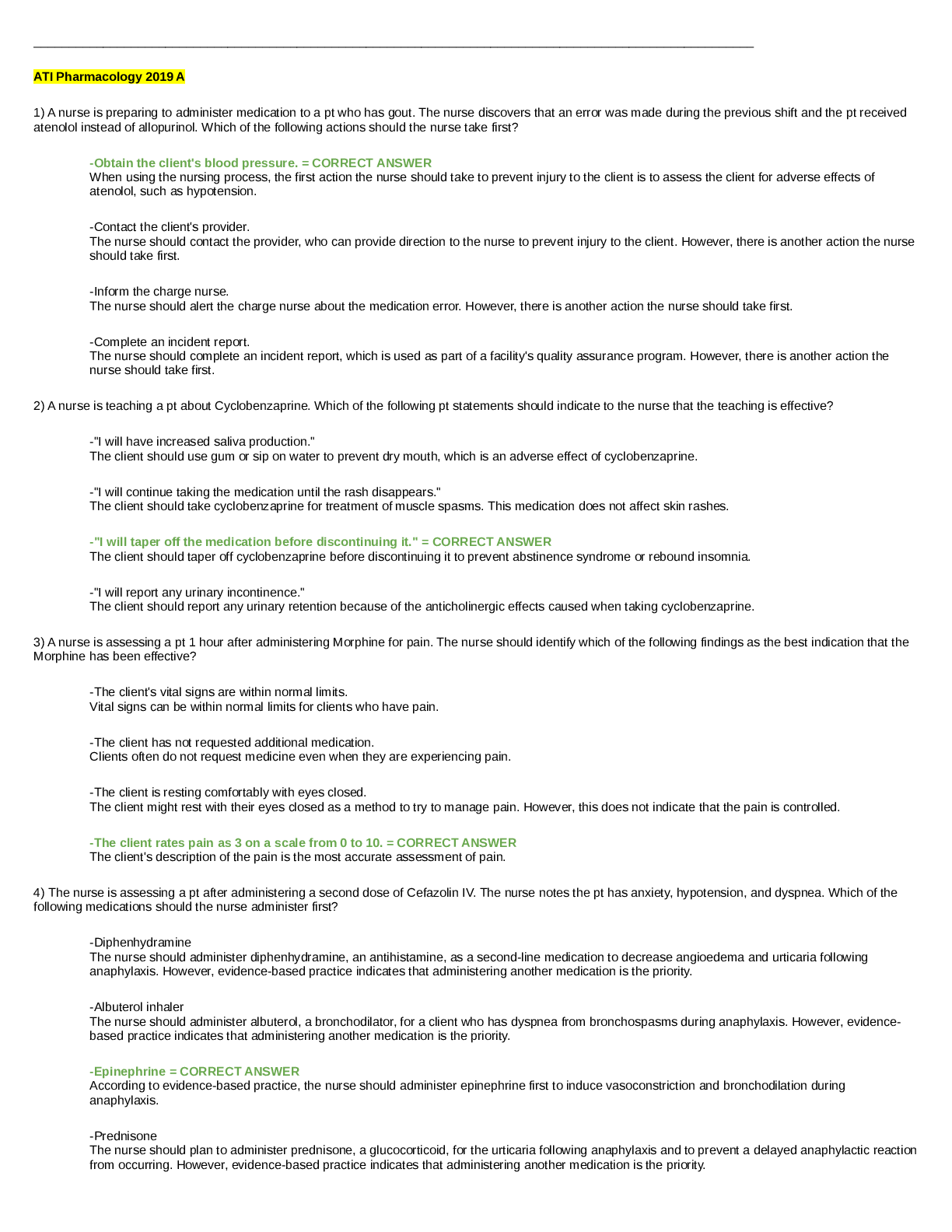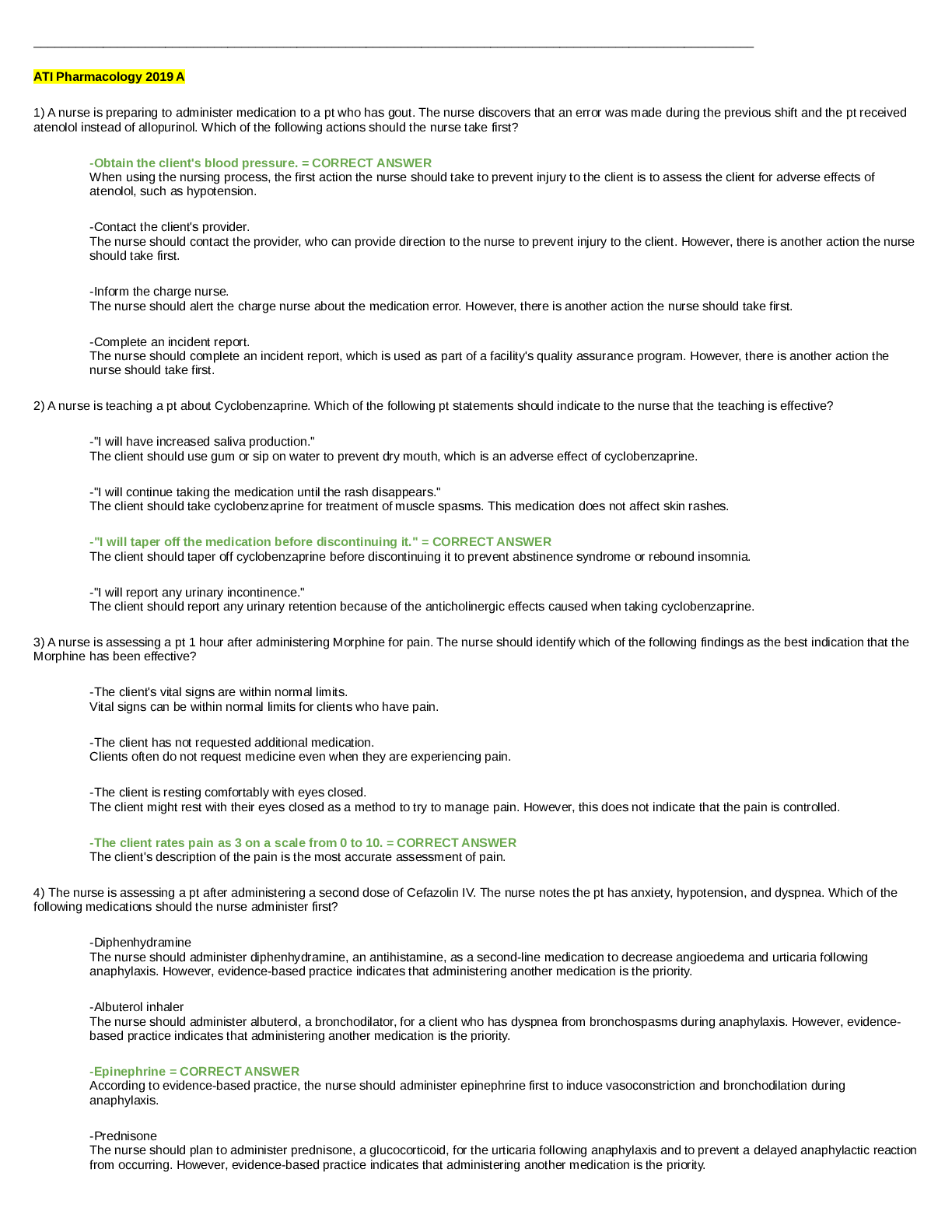1) A nurse is preparing to administer medication to a pt who has gout. The nurse discovers that an error was made during the previous shift and the pt received
atenolol instead of allopurinol. Which of the following actions should the nurse take first?
-Obtain the client's blood pressure. = CORRECT ANSWER
When using the nursing process, the first action the nurse should take to prevent injury to the client is to assess the client for adverse effects of
atenolol, such as hypotension.
-Contact the client's provider.
The nurse should contact the provider, who can provide direction to the nurse to prevent injury to the client. However, there is another action the nurse
should take first.
-Inform the charge nurse.
The nurse should alert the charge nurse about the medication error. However, there is another action the nurse should take first.
-Complete an incident report.
The nurse should complete an incident report, which is used as part of a facility's quality assurance program. However, there is another action the
nurse should take first.
2) A nurse is teaching a pt about Cyclobenzaprine. Which of the following pt statements should indicate to the nurse that the teaching is effective?
-"I will have increased saliva production."
The client should use gum or sip on water to prevent dry mouth, which is an adverse effect of cyclobenzaprine.
-"I will continue taking the medication until the rash disappears."
The client should take cyclobenzaprine for treatment of muscle spasms. This medication does not affect skin rashes.
-"I will taper off the medication before discontinuing it." = CORRECT ANSWER
The client should taper off cyclobenzaprine before discontinuing it to prevent abstinence syndrome or rebound insomnia.
-"I will report any urinary incontinence."
The client should report any urinary retention because of the anticholinergic effects caused when taking cyclobenzaprine.
3) A nurse is assessing a pt 1 hour after administering Morphine for pain. The nurse should identify which of the following findings as the best indication that the
Morphine has been effective?
-The client's vital signs are within normal limits.
Vital signs can be within normal limits for clients who have pain.
-The client has not requested additional medication.
Clients often do not request medicine even when they are experiencing pain.
-The client is resting comfortably with eyes closed.
The client might rest with their eyes closed as a method to try to manage pain. However, this does not indicate that the pain is controlled.
-The client rates pain as 3 on a scale from 0 to 10. = CORRECT ANSWER
The client's description of the pain is the most accurate assessment of pain.
4) The nurse is assessing a pt after administering a second dose of Cefazolin IV. The nurse notes the pt has anxiety, hypotension, and dyspnea. Which of the
following medications should the nurse administer first?
-Diphenhydramine
The nurse should administer diphenhydramine, an antihistamine, as a second-line medication to decrease angioedema and urticaria following
anaphylaxis. However, evidence-based practice indicates that administering another medication is the priority.
-Albuterol inhaler
The nurse should administer albuterol, a bronchodilator, for a client who has dyspnea from bronchospasms during anaphylaxis. However, evidence-
based practice indicates that administering another medication is the priority.
-Epinephrine = CORRECT ANSWER
According to evidence-based practice, the nurse should administer epinephrine first to induce vasoconstriction and bronchodilation during
anaphylaxis.
-Prednisone
The nurse should plan to administer prednisone, a glucocorticoid, for the urticaria following anaphylaxis and to prevent a delayed anaphylactic reaction
from occurring. However, evidence-based practice indicates that administering another medication is the priority.
Read More


